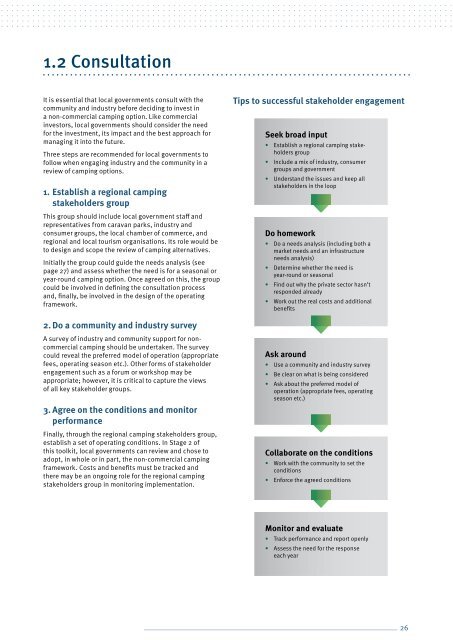qdts-camping-options-toolkit
qdts-camping-options-toolkit
qdts-camping-options-toolkit
You also want an ePaper? Increase the reach of your titles
YUMPU automatically turns print PDFs into web optimized ePapers that Google loves.
1.2 Consultation<br />
CS2059 Consultation diagram<br />
It is essential that local governments consult with the<br />
community and industry before deciding to invest in<br />
a non-commercial <strong>camping</strong> option. Like commercial<br />
investors, local governments should consider the need<br />
for the investment, its impact and the best approach for<br />
managing it into the future.<br />
Three steps are recommended for local governments to<br />
follow when engaging industry and the community in a<br />
review of <strong>camping</strong> <strong>options</strong>.<br />
1. Establish a regional <strong>camping</strong><br />
stakeholders group<br />
This group should include local government staff and<br />
representatives from caravan parks, industry and<br />
consumer groups, the local chamber of commerce, and<br />
regional and local tourism organisations. Its role would be<br />
to design and scope the review of <strong>camping</strong> alternatives.<br />
Initially the group could guide the needs analysis (see<br />
page 27) and assess whether the need is for a seasonal or<br />
year-round <strong>camping</strong> option. Once agreed on this, the group<br />
could be involved in defining the consultation process<br />
and, finally, be involved in the design of the operating<br />
framework.<br />
Tips to successful stakeholder engagement<br />
Seek broad input<br />
• Establish a regional <strong>camping</strong> stakeholders<br />
group<br />
• Include a mix of industry, consumer<br />
groups and government<br />
• Understand the issues and keep all<br />
stakeholders in the loop<br />
Do homework<br />
• Do a needs analysis (including both a<br />
market needs and an infrastructure<br />
needs analysis)<br />
• Determine whether the need is<br />
year-round or seasonal<br />
• Find out why the private sector hasn’t<br />
responded already<br />
• Work out the real costs and additional<br />
benefits<br />
2. Do a community and industry survey<br />
A survey of industry and community support for noncommercial<br />
<strong>camping</strong> should be undertaken. The survey<br />
could reveal the preferred model of operation (appropriate<br />
fees, operating season etc.). Other forms of stakeholder<br />
engagement such as a forum or workshop may be<br />
appropriate; however, it is critical to capture the views<br />
of all key stakeholder groups.<br />
3. Agree on the conditions and monitor<br />
performance<br />
Finally, through the regional <strong>camping</strong> stakeholders group,<br />
establish a set of operating conditions. In Stage 2 of<br />
this <strong>toolkit</strong>, local governments can review and chose to<br />
adopt, in whole or in part, the non-commercial <strong>camping</strong><br />
framework. Costs and benefits must be tracked and<br />
there may be an ongoing role for the regional <strong>camping</strong><br />
stakeholders group in monitoring implementation.<br />
Ask around<br />
• Use a community and industry survey<br />
• Be clear on what is being considered<br />
• Ask about the preferred model of<br />
operation (appropriate fees, operating<br />
season etc.)<br />
Collaborate on the conditions<br />
• Work with the community to set the<br />
conditions<br />
• Enforce the agreed conditions<br />
Monitor and evaluate<br />
• Track performance and report openly<br />
• Assess the need for the response<br />
each year<br />
26


